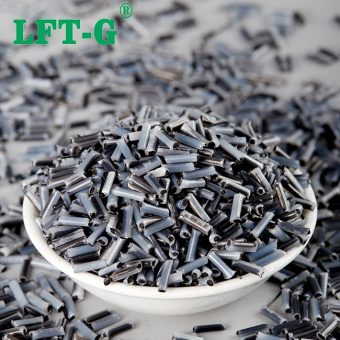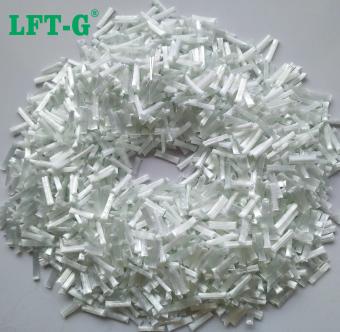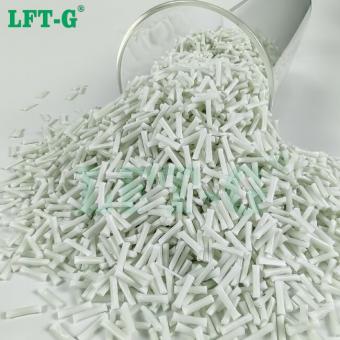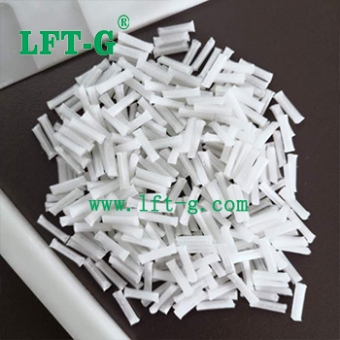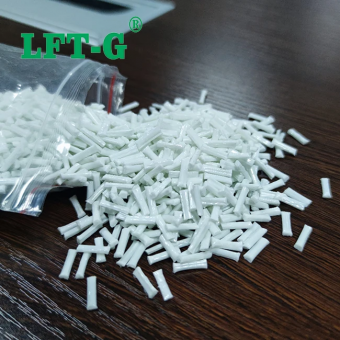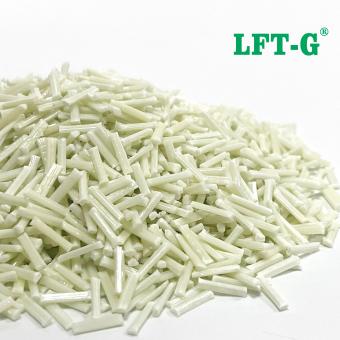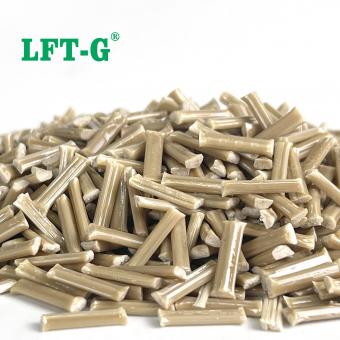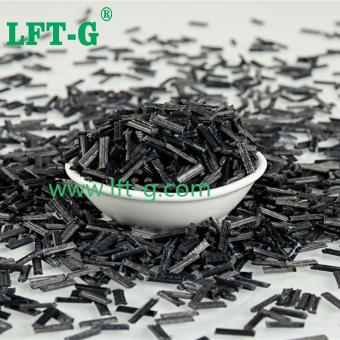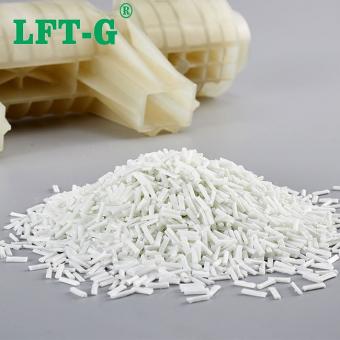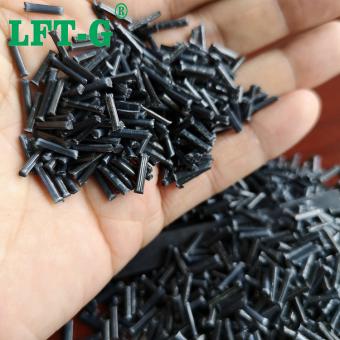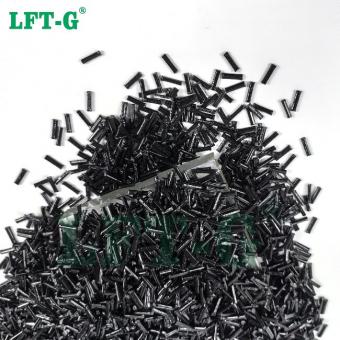-
LFT-G high rigidity PLA polylactic acid long carbon fiber reinforced material black color 10-12mm customizedPLA plastic Polylactic acid (PLA) fiber is made from starch raw materials such as corn and wheat, converted into lactic acid by fermentation, and then polymerized to obtain PLA, which is made by solution spinning or melt spinning. It is a fiber that completes the natural cycle and has biodegradability. The fiber does not use petroleum and other chemical materials at all, and its waste can be decomposed into carbon dioxide and water under the action of microorganisms in the soil and seawater, so it will not pollute the earth's environment. Since the initial raw material of this fiber is starch, its regeneration cycle is short, about one to two years, and the carbon dioxide it produces can be reduced in the atmosphere by plant photosynthesis. Long carbon fiber reinofrced PLA Carbon Fiber (CF) is an inorganic fiber containing more than 90% carbon. It is made by cracking carbonization of organic fibers under high temperature environment to form carbon main chain mechanism. As a new generation of reinforcing fibers, carbon fiber has excellent mechanical and chemical properties, including: 1) Light weight. Carbon fiber density and magnesium and beryllium is basically equivalent to less than 1/4 of steel, the use of carbon fiber composites as a structural component material can make the structure quality reduction of 30% -40%. 2) High strength and high modulus. The specific strength of carbon fiber is 5 times higher than that of steel and 4 times higher than that of aluminum alloy; the specific modulus is 1.3-12.3 times higher than that of other structural materials. 3) Small coefficient of expansion. Most of the carbon fiber at room temperature coefficient of thermal expansion is negative, the coefficient of thermal expansion under high temperature conditions is small, it is not easy due to high working temperature and expansion and deformation. 4) Good chemical corrosion resistance. In the acid, alkali environment are very stable performance, can be made into various types of chemical corrosion products. 5)Strong fatigue resistance. Its composite materials by stress fatigue millions of cycle test, strength retention rate is still 60%, while 40% of steel, aluminum for 30%, glass fiber reinforced plastic is only 20% -25%. Carbon fiber composites are the re-enforcement of carbon fiber. Although carbon fiber can be used alone and play a specific function, however, it is ultimately a brittle material, only with the combination of matrix materials to form carbon fiber composites, in order to better play the mechanical properties, to carry more load. Long carbon fiber & Short carbon fiber Long carbon fiber (LGF): 6-25mm/ High performance, high cost Short carbon fiber (SCF): less than 6mm/ Low performance, low cost In the composite material made of fibers is sheared or pulled, the fibers are pulled out from the matrix, such a pulling process is conducive to the absorption of energy provided by the loading, the longer the fibers are within a certain length, the greater the absorption of energy, and the more significant its strength. And in the same volume amount, due to the longer the single fiber, the fewer the number of fiber roots, the less stress concentration generated at the fiber end, the more difficult the destruction of the material. From the results of the feedback of practical applications, the various properties of long carbon fiber reinforced thermoplastic composites are more excellent than those of short fibers. ●Will the use of Xiamen LFT-G materials increase the cost? a. The unit cost of the material is slightly higher than aluminum alloy, but the cost/time of secondary metal processing can be saved, which is relatively advantageous overall. b. The unit cost of the material is slightly higher than that of a homogeneous staple fiber reinforced composite material, but LFRT has high dimensional stability, is not easily deformed, and can be assembled after demolding, which saves cooling/pressure retention time for molding and cost/time for fixing fixtures. Product processing Warehouse & laboratory Main products
- Long carbon fiber Reinforced PLA for electrial accessories
- Injection molded PLA green materials lcf
- PLA Composite Pellets long carbon fiber filled
- PLA modified plastic instead metal
- pla polymers pellets long fiber
- LFT-G pla high mechanical properties
Tags :
-
Xiamen LFT-G PLA Polylactic acid filling Long carbon fiber modified compunds high performancePLA information PLA, also known as polylactide, refers to the polyester polymer obtained by polymerization of lactic acid as the main raw material, usually using renewable plant resources (such as corn, cassava, etc.) made of starch as raw material. It is a new type of renewable biodegradable material. PLA material characteristics The raw materials are renewable and relatively easy to obtain even if used as 3D printing materials, which can be used for large-scale production; The PLA has good thermal stability and solvent resistance. The processing temperature of PLA is between 170 ℃ and 230℃, and the finished product has good heat resistance. Good permeability and transparency luster, can be processed by extrusion, spinning, biaxial stretching, injection blow molding and other ways, tensile and bending modulus can be comparable to the traditional plastic resin; High biocompatibility. The monomer material of PLA, L-lactic acid, is an endogenous active substance in human body. Therefore, the finished product printed by 3D printing material PLA is non-toxic to human body and can be absorbed by human body. It has good degradability. Different from the degradation methods of other 3D printing materials, PLA is embedded in the soil and completely degraded by microorganisms in nature under specific conditions to generate carbon dioxide and water. The carbon dioxide generated directly enters the soil organic matter or is absorbed by plants instead of being discharged into the air, which is recognized as an environmentally friendly material. Application of PLA materials Due to the good mechanical and physical properties of PLA material, PLA material is widely used, including various food containers, packaged food, fast food lunch boxes, etc. At the same time, with its advantages in compatibility and degradability, PLA can also play a large role in the medical field, which can be made into medical tissue skeleton material and medical carrier for human body. In addition to its excellent tensile strength and extensibility, PLA can be produced by various common processing methods, such as melt extrusion molding, injection molding, blow film molding, foam molding and vacuum molding. About us
- polylactide can be recycled plastic
- biodegradable materials made in China
- new renewable plastic pla
- PLA-LCF composite made in China
- low warpage plastic pla green materials
- industrial use pla injection molding
Tags :
-
Xiamen LFT-G PLA Polylactic Acid filling long glass fiber thermoplastic original colorWhat is PLA material? Polylactic acid (PLA) is a new bio-based and renewable biodegradable material made from starch extracted from renewable plant resources such as maize and cassava. Starch raw materials through saccharification to obtain glucose, and then from the glucose and a certain strain fermentation into high purity lactic acid, and then through chemical synthesis of a certain molecular weight of polylactic acid, the polymerization chain is as follows. Starch (refined) -- - > glucose (fermentation) -- - > lactic acid (cyclic) -- - > lactide (polymerization) -- - > the PLA PLA is the "green plastic" with the greatest development potential in the 21st century. It has good mechanical properties and transparency, but its shortcomings such as slow crystallization rate and poor heat resistance limit its popularization and use. Therefore, some toughening method is often used to enhance its performance, but at the expense of transparency or complex process. What is PLA LGF material? The rigidity of the fiber makes it play the role of skeleton support in the polymer matrix. When the polymer is heated, the movement of the chain segment is limited, thus improving the heat resistance of the material At present, carbon fiber and glass fiber can be used to enhance the modification of PLA. Among these fibers, carbon fiber and glass fiber are widely used because of their high strength and modulus. The composite material was prepared by adding fiber into PLA. After heat treatment, the modification effect of the composite material was the best, and the heat resistance temperature was increased by nearly 40℃ compared with that of pure PLA. Two or more materials with synergistic effect can be added at the same time to improve the thermal performance of PLA. The test results show that the Vica softening temperature of the composites exceeds 140℃. Production process Details Other products you may wonder PP-LGF PA6-LGF TPU-LGF Frequently asked questions Q. Does long glass fiber and long carbon fiber injection have special requirements for injection molding machines and molds? A. There are certainly requirements. Especially from the product design structure, as well as the injection molding machine screw nozzle and mold structure injection molding process must consider the requirements of long fiber. Q. The product is easy to brittle, so changing to use long fiber reinforced thermoplastic materials can solve this problem? A. The overall mechanical properties must be improved. The characteristics of long glass fiber and long carbon fiber are the advantages in mechanical properties. It has 1-3 times higher (toughness) than short fiber, and the tensile strength (strength and rigidity) is increased by 0.5-1 times. Q. When a customer want to develop a new product, how to recommend customers suitable material and characteristics? A. It is necessary to understand the customer's technical requirements, use environment, test conditions for the new product, and recommend the model according to various kind of long-fiber resin substrate characteristics.
- long glass fiber Polylactic acid
- LGF injection molding PLA compounds
- PLA green materials GF can be recycled
- high rigidity glass filled pla filament composite
- glass filled pla high performance
- made in China self factory home appliances
Tags :
-
LFT-G PLA Polylactic acid filling long glass fiber thermoplastic resin original color for automotive partsWhat is PLA material? Polylactic acid (PLA) is a new bio-based and renewable biodegradable material made from starch extracted from renewable plant resources such as maize and cassava. Starch raw materials through saccharification to obtain glucose, and then from the glucose and a certain strain fermentation into high purity lactic acid, and then through chemical synthesis of a certain molecular weight of polylactic acid, the polymerization chain is as follows. Starch (refined) -- - > glucose (fermentation) -- - > lactic acid (cyclic) -- - > lactide (polymerization) -- - > the PLA PLA is the "green plastic" with the greatest development potential in the 21st century. It has good mechanical properties and transparency, but its shortcomings such as slow crystallization rate and poor heat resistance limit its popularization and use. Therefore, some toughening method is often used to enhance its performance, but at the expense of transparency or complex process. What is PLA LGF material? The rigidity of the fiber makes it play the role of skeleton support in the polymer matrix. When the polymer is heated, the movement of the chain segment is limited, thus improving the heat resistance of the material At present, carbon fiber and glass fiber can be used to enhance the modification of PLA. Among these fibers, carbon fiber and glass fiber are widely used because of their high strength and modulus. The composite material was prepared by adding fiber into PLA. After heat treatment, the modification effect of the composite material was the best, and the heat resistance temperature was increased by nearly 40℃ compared with that of pure PLA. Two or more materials with synergistic effect can be added at the same time to improve the thermal performance of PLA. The test results show that the Vica softening temperature of the composites exceeds 140℃. Production process Details Other products you may wonder PP-LGF PA6-LGF TPU-LGF Frequently asked questions Q. Does long glass fiber and long carbon fiber injection have special requirements for injection molding machines and molds? A. There are certainly requirements. Especially from the product design structure, as well as the injection molding machine screw nozzle and mold structure injection molding process must consider the requirements of long fiber. Q. The product is easy to brittle, so changing to use long fiber reinforced thermoplastic materials can solve this problem? A. The overall mechanical properties must be improved. The characteristics of long glass fiber and long carbon fiber are the advantages in mechanical properties. It has 1-3 times higher (toughness) than short fiber, and the tensile strength (strength and rigidity) is increased by 0.5-1 times. Q. When a customer want to develop a new product, how to recommend customers suitable material and characteristics? A. It is necessary to understand the customer's technical requirements, use environment, test conditions for the new product, and recommend the model according to various kind of long-fiber resin substrate characteristics.view more
-
LFT PLA Manufacturer Carbon Fiber filled Compounds green materialsPLA long carbon fiber reinforced materials offer improved strength, stiffness, and dimensional stability compared to standard PLA, while maintaining its biodegradability. They are ideal for eco-friendly applications requiring lightweight and enhanced mechanical performance.
- PLA recycled
- automotive thermoplastic composites
- pla green materials
- PLA Carbon
- carbon fiber pellets
- can pla be recycled?
Tags :
-
High Performance Long Fiber PLA Lightweight Metal Replacement SolutionLong Fiber Reinforced PLA (LFR-PLA) is an engineering plastic that combines long glass fibers with polylactic acid (PLA) resin. PLA itself is an environmentally friendly thermoplastic, known for its biodegradability. However, it has limited mechanical properties, such as strength, toughness, and heat resistance. By incorporating long glass fibers, the performance of PLA is significantly improved, making it suitable for demanding applications.
- PLA Green materials
- PLA recycled plastics
- composite materials in renewable energy market
- glass filled PLA filament
- long fiber filling materials
- Polylactic acid
Tags :
-
China Carbon Fiber PLA Modified CompoundsLong Fiber Reinforced PLA (LFR-PLA) is an engineering plastic that combines long glass fibers with polylactic acid (PLA) resin. PLA itself is an environmentally friendly thermoplastic, known for its biodegradability. However, it has limited mechanical properties, such as strength, toughness, and heat resistance.
- carbon reinforced PLA
- PLA green materials
- pla recycled materials
- PLA composites
- carbon fiber reinforced plastic
- china carbon fiber
Tags :

 e-mail
e-mail English
English français
français Deutsch
Deutsch русский
русский italiano
italiano español
español português
português العربية
العربية 日本語
日本語 한국의
한국의 中文
中文





